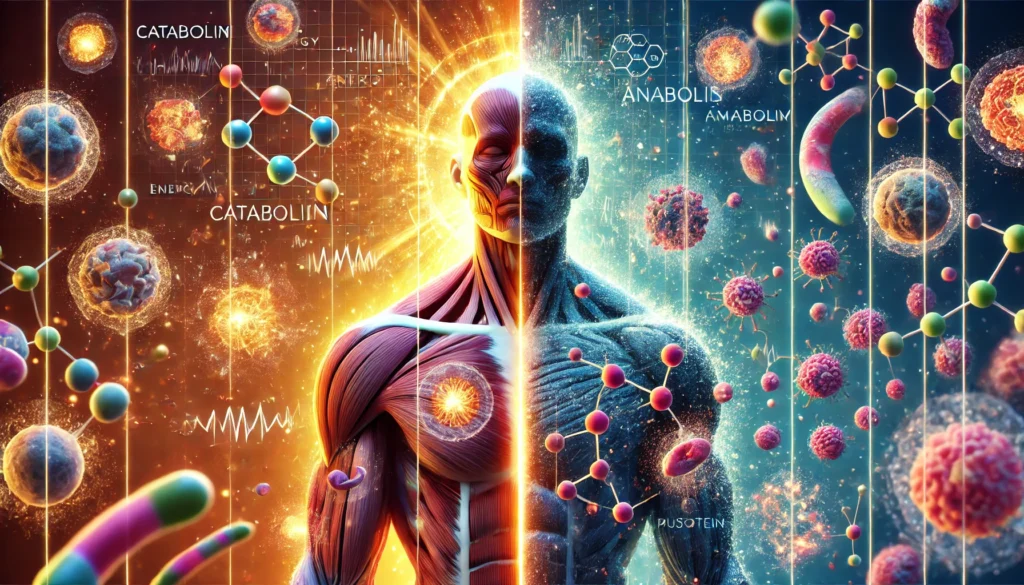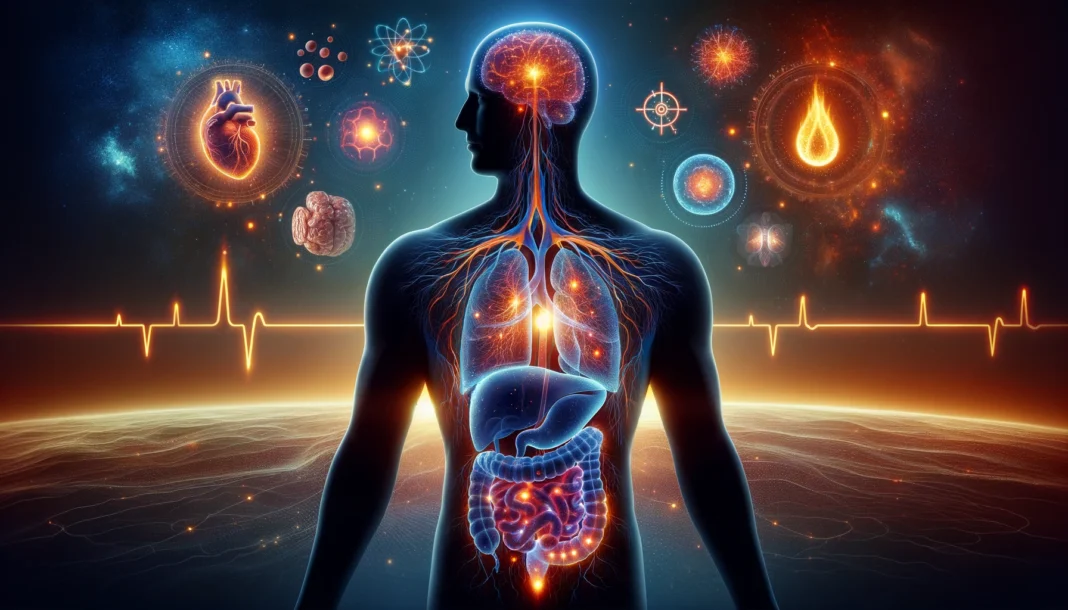Introduction
Metabolism is the unsung hero of human physiology. It determines how efficiently your body converts food into usable energy, how well it burns calories at rest, and how easily you gain or lose weight. In everyday language, people often refer to this inner engine in simplified terms—fast metabolism or slow metabolism—but behind these expressions lies a deeply intricate system regulated by hormones, muscle mass, genetic factors, and lifestyle choices. If you’ve ever wondered how to increase metabolism or questioned how to know if your metabolism is fast or slow, you’re not alone. These concerns have become central in conversations about weight management, energy levels, and long-term health.
You may also like: Do Carbs Cause Brain Fog? What Science Reveals About Carbohydrates and Mental Clarity
Your basal metabolic rate (BMR) is a core component of this equation—it represents the number of calories your body needs to function at rest. Surprisingly, this resting energy demand accounts for up to 70% of your daily caloric burn. So understanding what factors affect your BMR, or trying to list two factors that affect your BMR, becomes crucial in the journey toward a more efficient metabolism. In fact, knowing how to increase your BMR can lead to better outcomes than simply focusing on exercise or diet alone.
This comprehensive guide explores every facet of metabolism: the science behind it, common misconceptions, signs your metabolic system may be sluggish, and what you can do to enhance it. From metabolism boosting foods to lifestyle hacks and medical considerations, we’ll examine strategies backed by evidence and expert consensus. Whether you’re in your 20s or wondering how to increase metabolism after 40, this article will provide practical, research-based tools to help you take control of your body’s metabolic performance.
If you’re asking questions like how can we increase metabolism, what does fast metabolism mean, or how to make your metabolism faster, prepare for a deep dive into one of the most important yet misunderstood aspects of human health.

What Is Metabolism and Why Does It Matter?
Metabolism refers to all chemical reactions in your body that convert food into energy. These reactions are divided into two main categories: catabolism, which breaks down molecules for energy, and anabolism, which builds new cells and maintains tissues. Together, these processes ensure that your body can perform vital functions—like breathing, circulation, and cell repair—even when you’re doing nothing at all.
When people talk about fast metabolism or slow metabolism, they’re usually referencing how quickly their body burns calories. A high metabolism often means your body uses energy more efficiently and burns more calories at rest, while a slower metabolism may result in fatigue, weight gain, or cold sensitivity. However, these terms oversimplify a highly complex system influenced by numerous variables.
Your BMR is the baseline number of calories you need daily just to survive—no movement, no digestion, just basic physiological function. When trying to increase metabolism, it’s essential to understand how to influence your BMR through both internal and external factors. For example, if you were to list two factors that affect your BMR, age and lean muscle mass would be top contenders. But these are just the beginning.
The metabolic rate also includes the thermic effect of food (TEF), which refers to the calories burned during digestion, and activity energy expenditure, which covers both exercise and non-exercise movement like walking or fidgeting. Together, these elements contribute to your total daily energy expenditure (TDEE).
Why does this matter? Because your metabolism determines not just your weight, but your energy levels, hormonal balance, and even your mental clarity. If you’ve ever felt sluggish after a carb-heavy meal or noticed weight changes despite the same caloric intake, metabolism is likely at play.
Understanding and influencing this system is not just about aesthetics—it’s about optimizing how your body operates at every level.
What Does Fast Metabolism Mean?
The term fast metabolism generally describes a condition in which the body efficiently burns calories at rest and during activity. Individuals with a fast metabolism tend to require more calories to maintain weight, often experience increased energy, and may find it easier to stay lean. But what does this actually mean from a biological perspective?
A fast metabolism is characterized by high BMR levels, meaning the body is constantly burning a significant amount of energy even at rest. Several variables contribute to this, including greater muscle mass, higher thyroid hormone levels, and a more active sympathetic nervous system. People with naturally high BMRs typically experience warmer body temperatures and higher resting heart rates, which reflect increased metabolic activity.
Understanding how to know if your metabolism is fast starts with looking at certain physiological clues. Common signs include frequent hunger, difficulty gaining weight despite eating large amounts of food, consistent energy throughout the day, and efficient digestion. If these attributes sound familiar, it may indicate that your body is operating with a relatively high metabolic rate.
But not everyone is born with this advantage. The good news is that you can influence many of the variables associated with metabolic speed. Exercise, nutrition, sleep, and even environmental exposure can collectively impact your metabolic profile. That’s why learning how to get a fast metabolism or how to raise your metabolism involves both understanding your baseline and strategically improving it.
While having a fast metabolism may seem like a blessing, it can also pose challenges—particularly if it leads to difficulty maintaining weight or nutritional balance. In such cases, individuals must focus on nutrient-dense, calorie-rich foods and strength training to maintain both weight and muscle mass.
Ultimately, the goal isn’t just to chase a fast metabolism for its own sake, but to find a metabolic rhythm that supports your lifestyle, body composition, and long-term health goals.

Two Factors That Affect BMR and Why They Matter
If you’ve ever tried to list two factors that affect your BMR, chances are age and muscle mass came to mind. These are among the most significant influencers of your basal metabolic rate, but let’s explore why they matter in scientific terms.
First, age plays a major role in slowing metabolism. As you get older, your BMR naturally declines—often due to reduced physical activity, hormonal shifts, and a loss of lean muscle mass. For example, someone in their 60s may burn significantly fewer calories at rest compared to someone in their 20s, even if their weight remains constant. This is one reason why individuals often seek strategies for how to increase metabolism after 40—the natural decline can impact weight, energy, and even mood.
Second, lean muscle mass is a critical determinant of metabolic rate. Muscle tissue is metabolically active, meaning it requires more energy to maintain than fat tissue. For every pound of muscle gained, your body burns an additional 6–10 calories per day at rest. This may not sound like much, but when scaled over the entire body and combined with physical activity, the impact is substantial.
If you were to list 2 factors that affect your BMR or explore what factors affect your BMR more comprehensively, you’d also include genetics, hormone levels (especially thyroid and insulin), gender, and body size. Men typically have higher BMRs due to greater muscle mass, while women may experience fluctuations based on reproductive hormones.
Knowing this, it’s clear that the answer to how to increase your BMR lies in strategies that increase or preserve muscle, balance hormones, and improve cellular efficiency. This forms the foundation for actionable plans to raise your metabolism and support metabolic health throughout all stages of life.

Signs of a Slow Metabolism
Sometimes the body gives clear signals that its internal engine is not running at optimal speed. Recognizing the signs of slow metabolism is the first step toward correction. While these signs can be subtle, they often point toward inefficiencies in energy production, hormone regulation, and cellular health.
One of the most common symptoms is unexplained weight gain or an inability to lose weight despite a consistent diet and exercise routine. Because metabolism influences calorie burn at rest, a slower rate means fewer calories are burned throughout the day, making weight management more difficult.
Another hallmark is persistent fatigue. Even after a full night of sleep, individuals with sluggish metabolism may feel tired, mentally foggy, or lacking in motivation. This happens because cellular energy production is diminished, impacting both physical and cognitive performance.
Cold sensitivity is another frequently reported symptom. Since metabolic processes generate heat, a low metabolic rate may result in feeling cold more often, especially in extremities like hands and feet. Coupled with dry skin, hair thinning, or brittle nails, these symptoms can indicate hormonal imbalances affecting metabolic function.
Additionally, irregular menstrual cycles or low libido can be linked to poor metabolic health, particularly when hormone levels are out of balance. These reproductive signals often reflect broader systemic issues that impact metabolism, such as hypothyroidism or insulin resistance.
If you recognize multiple signs of slow metabolism in your own body, it’s essential to explore targeted strategies to boost metabolic function. Whether you’re considering metabolism boosters, dietary adjustments, or specific exercises, listening to your body’s cues can guide you toward more effective interventions.
How to Know If Your Metabolism Is Fast or Slow
Understanding how to know if your metabolism is fast or slow involves observing key physical and behavioral markers in combination with metabolic testing when necessary. While professional assessments such as indirect calorimetry or resting metabolic rate (RMR) tests can offer precise insights, most people can glean valuable information by paying close attention to how their body responds to food, activity, and rest.
If you often feel hungry shortly after eating, have consistent bowel movements, maintain a healthy weight despite a high-calorie intake, and generally feel energetic throughout the day, these are classic signs of a fast metabolism. You might also notice that you stay warm more easily and that your recovery after exercise is quick.
In contrast, those with slower metabolism may experience sluggish digestion, frequent fatigue, difficulty losing weight, cold extremities, or general lethargy. A slower resting heart rate and dry skin are also common signs. For women, irregular menstrual cycles and water retention may be additional indicators that the body’s energy systems are not operating optimally.
In some cases, a person may show signs of both—such as gaining weight easily but still feeling wired or anxious. This could point to hormonal dysregulation, such as elevated cortisol or insulin resistance, which can complicate metabolic efficiency.
Tracking your food intake, energy levels, sleep quality, and mood over a few weeks can help you determine your metabolic trends. Apps or wearables that measure your activity, heart rate, and sleep can further guide your understanding of whether your metabolism is functioning efficiently or not.
Whether your goal is to speed up metabolism, increase your BMR, or simply understand your body better, identifying your baseline is a crucial first step toward targeted change.

How to Speed Up Metabolism Naturally
Knowing how to speed up metabolism requires a multifaceted approach that includes exercise, diet, sleep, and stress management. While there’s no magic switch, small consistent changes can lead to substantial improvements in how your body generates and uses energy.
One of the most powerful methods is through resistance training. Lifting weights or engaging in bodyweight exercises builds muscle, which in turn raises your BMR. As discussed earlier, muscle tissue is metabolically active, and maintaining it requires more energy than fat.
High-intensity interval training (HIIT) is another proven method to increase metabolic rate. Unlike steady-state cardio, HIIT workouts create an “afterburn effect” where the body continues to burn calories even after the session is over. This can lead to significant boosts in overall metabolic activity throughout the day.
Proper hydration is an often-overlooked component of metabolic health. Water is involved in almost every metabolic process, and even mild dehydration can impair energy production at the cellular level. Drinking enough water also supports digestion, nutrient transport, and thermoregulation—all essential to maintaining a fast metabolism.
Sleep quality is equally crucial. Studies show that poor sleep decreases leptin (the hormone that suppresses hunger) and increases ghrelin (which stimulates appetite), leading to overeating and slowed metabolism. Aim for 7–9 hours of uninterrupted sleep in a dark, cool environment to support hormonal balance and metabolic function.
Stress reduction through practices like mindfulness, yoga, or deep breathing can lower cortisol levels. Chronic stress is a known metabolism suppressor, often leading to fat storage—particularly around the abdomen—and fatigue.
Incorporating these practices into your lifestyle not only helps make your metabolism faster but also improves overall health, energy levels, and emotional resilience.

Best Foods That Increase Metabolism
Nutrition plays a fundamental role in metabolic regulation. Knowing which foods that increase metabolism can support your goals is essential. These foods enhance thermogenesis (the calorie-burning process during digestion) and support mitochondrial function, hormonal balance, and nutrient absorption.
Protein-rich foods such as lean meats, eggs, legumes, and tofu require more energy to digest than fats or carbs. This is called the thermic effect of food (TEF). Protein can increase TEF by 15–30%, compared to just 5–10% for carbs and 0–3% for fats. Eating enough protein also preserves muscle mass during weight loss, keeping your BMR high.
Spicy foods, particularly those containing capsaicin (found in chili peppers), can temporarily boost metabolic rate by increasing thermogenesis and fat oxidation. While not a long-term solution alone, they can complement a metabolism-enhancing diet.
Green tea and coffee contain caffeine and catechins, which can increase fat oxidation and energy expenditure. Moderate coffee consumption is linked to better metabolic function, especially when combined with exercise. Just avoid sugar-laden versions that can negate the benefits.
Whole grains like oats, quinoa, and brown rice are complex carbohydrates rich in fiber and B vitamins. These support insulin sensitivity, regulate blood sugar, and keep you fuller longer—all of which assist metabolic efficiency.
Leafy greens and cruciferous vegetables such as spinach, kale, broccoli, and Brussels sprouts are rich in fiber, antioxidants, and metabolism-supporting nutrients like magnesium and iron.
If you’re wondering what foods speed up female metabolism in particular, those rich in iron and B12 are especially important due to menstrual blood loss and higher nutrient needs during hormonal fluctuations. Pairing iron-rich foods with vitamin C sources enhances absorption and maximizes metabolic benefit.
Choosing the right metabolism boosting foods helps optimize your internal engine, allowing your body to burn fuel more efficiently, store less fat, and maintain consistent energy.
How to Increase Metabolism After 40
A common concern is how aging impacts metabolism, especially after the age of 40. Hormonal shifts, decreased physical activity, and changes in muscle mass can all contribute to a gradual metabolic slowdown. But learning how to increase metabolism after 40 can help you maintain health, vitality, and body composition well into midlife and beyond.
One of the first strategies is to prioritize resistance training. As you age, sarcopenia—or age-related muscle loss—becomes a real concern. Lifting weights or using resistance bands helps preserve muscle and bone density while keeping your metabolic engine active.
Protein intake should be increased slightly compared to younger adults, as your body becomes less efficient at synthesizing new muscle tissue. Aim for high-quality sources spread throughout the day to support muscle repair and hormonal regulation.
Sleep and stress management become more critical than ever. Midlife often brings increased responsibilities—career, caregiving, finances—that can chronically elevate cortisol and suppress metabolism. Mindful practices, regular sleep schedules, and even biofeedback tools can help manage these stressors and maintain hormonal balance.
In women, perimenopause and menopause can affect estrogen levels, which are linked to fat storage, insulin sensitivity, and metabolic rate. Tracking changes with a qualified practitioner and using nutrition, lifestyle, and medical support when necessary can make a significant difference.
Thyroid function should also be monitored. Hypothyroidism becomes more common with age and is a major contributor to metabolic slowdowns. Symptoms like weight gain, fatigue, and cold sensitivity should prompt a checkup and lab work.
By being proactive and tailoring your habits to your body’s changing needs, you can continue to raise your metabolism and maintain a strong, energized, and healthy system well beyond 40.
Frequently Asked Questions
1. What are two factors that affect BMR the most?
The two most influential factors that affect BMR are muscle mass and age. Muscle is a metabolically active tissue that burns more calories at rest than fat, which means individuals with more lean body mass have higher basal metabolic rates. Age, on the other hand, tends to lower BMR due to a natural loss of muscle and shifts in hormone levels. As people get older, they tend to lose lean muscle unless actively maintaining it through exercise and proper nutrition. This is why strategies aimed at increasing muscle mass and preserving hormonal health are crucial for improving BMR across the lifespan.
2. How do I know if my metabolism is slow?
Signs of a slow metabolism include unexplained weight gain, persistent fatigue, feeling cold often, hair thinning, dry skin, difficulty concentrating, and irregular bowel movements. You might also notice that you’re not losing weight despite eating less and exercising more. Tracking these symptoms over time, especially alongside changes in body composition or energy levels, can help identify a metabolic slowdown. If these symptoms persist, it’s wise to consult a healthcare provider for blood tests, including thyroid function and hormone panels.
3. What foods help speed up female metabolism?
Foods that help speed up female metabolism include lean protein sources like chicken and legumes, iron-rich vegetables such as spinach and kale, and whole grains like quinoa and brown rice. Spices like turmeric and cayenne pepper, along with drinks like green tea, can enhance thermogenesis. Because women are more prone to iron deficiency, which can impair energy metabolism, foods that restore iron stores are especially beneficial. Ensuring adequate B vitamins, magnesium, and fiber also helps support hormone balance and metabolic efficiency.
4. Can metabolism boosters actually work?
Metabolism boosters can work, but they are not a standalone solution. Natural boosters such as caffeine, green tea extract, capsaicin, and certain adaptogens may enhance calorie burn slightly, especially when combined with exercise. However, the most effective metabolism enhancer remains building lean muscle through resistance training and maintaining good sleep, stress, and nutritional habits. Some over-the-counter products labeled as metabolism boosters may contain stimulants or unregulated ingredients, so it’s crucial to choose clinically supported options and consult a health professional when needed.
5. How can I raise my metabolism every day?
You can raise your metabolism daily through small, consistent habits. Start with strength training a few times a week and incorporate short HIIT workouts. Prioritize protein in every meal and stay well hydrated. Break up long periods of sitting with movement throughout the day. Sleep at least 7–8 hours nightly and reduce stress through mindfulness or relaxation exercises. Simple acts like drinking cold water, walking after meals, and stretching in the morning can also create cumulative benefits over time.
6. Are there specific metabolism boosters for women?
Yes, some metabolism boosters are particularly tailored for women. These include iron-rich foods to combat menstrual blood loss, adaptogens like ashwagandha to regulate cortisol, and supplements like vitamin B12 and magnesium that support hormonal health. Women may also benefit from protein timing around workouts and prioritizing foods that support thyroid function, such as those high in selenium and iodine. Lifestyle factors such as stress, sleep, and reproductive hormone balance are especially impactful on female metabolism.
7. How do metabolism boosting foods actually work?
Metabolism boosting foods work by enhancing thermogenesis, improving insulin sensitivity, and supporting the mitochondria—the powerhouse of cells. For example, high-protein foods require more energy to digest and help preserve lean muscle mass, which in turn raises BMR. Spicy foods increase internal heat and calorie burn. Whole foods rich in antioxidants help reduce inflammation, which can otherwise impair metabolic function. The synergistic effect of these foods over time can lead to a more efficient and resilient metabolism.
8. What is the best way to get a fast metabolism?
The best way to get a fast metabolism involves building lean muscle through resistance training, eating enough protein, getting quality sleep, and managing stress. Daily habits like walking, stretching, and staying hydrated also help. Supplementing with metabolism-supporting nutrients and focusing on whole, minimally processed foods can further enhance your efforts. Avoid crash diets, as they slow metabolism over time. Instead, aim for consistency in habits that build a healthy, adaptive metabolic system.
9. Does a high metabolism mean I can eat anything?
Not necessarily. While a high metabolism allows you to burn more calories at rest and during activity, it doesn’t mean your body is immune to the negative effects of poor diet. People with a fast metabolism still need balanced nutrients for cellular function, immune support, and hormone regulation. Overeating processed or nutrient-poor foods can still lead to inflammation, digestive issues, or nutrient deficiencies—even if weight gain isn’t immediately apparent. Quality matters just as much as quantity when it comes to fueling your body.
10. Can you improve metabolism permanently?
Yes, you can improve your metabolism long-term through sustained lifestyle changes. Building and maintaining muscle, improving sleep hygiene, reducing chronic stress, and eating a diet rich in whole foods all contribute to lasting metabolic improvements. While some aspects like genetics or age are not modifiable, many other variables are within your control. The key is consistency—small daily efforts compound over time and create a more metabolically flexible and efficient body for years to come.

Conclusion
Understanding how to increase metabolism is not just about calorie burn or body image—it’s about optimizing how your body functions on a foundational level. Whether your goal is more energy, better weight control, or improved longevity, enhancing your metabolic rate plays a pivotal role. From identifying two factors that affect your BMR—like age and muscle mass—to exploring the most effective metabolism boosting foods, the journey is rooted in both science and self-awareness.
We’ve explored how to raise your metabolism, how to recognize the signs of slow metabolism, and actionable strategies like strength training, high-protein nutrition, quality sleep, and smart stress management. These principles apply across all ages and are especially important as you navigate life transitions, including the quest to increase metabolism after 40.
Most importantly, this is not a one-size-fits-all equation. Learning how to know if your metabolism is fast or slow gives you the data needed to tailor your approach. Whether you’re seeking a metabolism booster for women, looking to speed up metabolism, or simply want to maintain what you have, the path forward is one of consistency, curiosity, and care.
Metabolism is not a mystery—it’s a map. And once you understand its routes, you can travel farther, faster, and with more energy than ever before.
Was this article helpful? Don’t let it stop with you. Share it right now with someone who needs to see it—whether it’s a friend, a colleague, or your whole network. And if staying ahead on this topic matters to you, subscribe to this publication for the most up-to-date information. You’ll get the latest insights delivered straight to you—no searching, no missing out.
Further Reading:
My Brain Is Fried: Scientific Reasons Your Mind Feels Overworked and What to Do About It
Metabolic Confusion Diet Plan: How to Boost Fat Loss With Science



